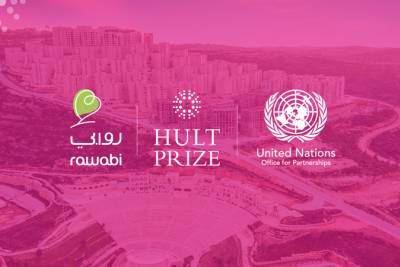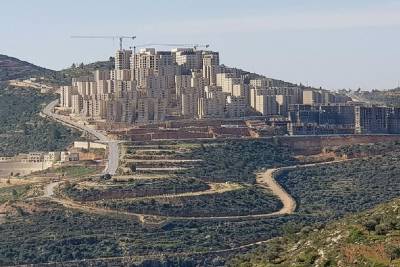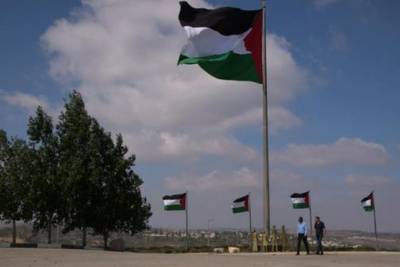Palestinians build modern city
Christians for Israel - Alfred Muller - RAWABI - The driver maneuvered the bus along a narrow winding road. On the right side, a gaping chasm. As far as the eye can see, we see hills. In the vicinity are some green through the winter rains, which are gray in the distance because of the fog. Some small villages are spread over the mountains, with a minaret in their midst.
To a large fence that suddenly there beside us, waving Palestinian flags and the white-green flags of Rawabi. The door buzzes open and we step out. In the distance a bulldozer created a huge dust cloud. There is a severe wind and dust stings the eyes. A few Palestinians in yellow with bright green vests and helmets with the word "Rawabi, walk up to us to speak to us.
Architect and urban Shireen Nazer blank box folds open a map. She studied architecture at the University of Bir Zeit and city planning in France. When the project began two years ago, she was right to work. Ready for the latest planning knowledge into practice. Her finger slides over the lines and squares: streets, green spaces, mosques, schools, public centers, clinics, hiking trails, fire station, police station and church. "All residents get within 300 meters of their house a small supermarket."
Plateaus
Behind us are digging long yellowish gray shelves built into the hills. In addition, the city center with public buildings. The groundwork began in January and construction started this summer.
"The Palestinian Ministry of Local Government approved the construction on 630 acres of good," added the blank box. "We are now working on the first 14 acres."
Nazer is aware that a new city at risk to miss the atmosphere oudoosterse other Arab cities.
"In the Old City of Jerusalem and Nablus are areas where only pedestrians are. Which we explain here as well. We will not build houses with red roofs. That do not fit in the ArabPalestinian culture. We use the block. "
Engineer Tariq Nazzal (34) tells that the city developers have asked the Palestinian water authority to supply enough water. He does not know whether the service of the Israeli company Mekorot will, or whether it will tap its own resources. The place also gets a sewage treatment plant.
Rawabi is a modern city, well equipped and based on the latest planning insights. "This is a city where children can play safely," he promises. "I would later live. The first house I was concerned, was leaking. "
In Ramallah
We also visit Bashar Masri in Ramallah. His office is located in one of the new advanced buildings in the Palestinian city. Rawabi the idea of this 49-year-old Palestinian-American businessman who comes from a wealthy family from Egypt who settled earlier in Nablus. He says that when the plan was born, he went to the Arab world to find investors. In Qatar, he conducted interviews for two days. Then the big investment Qatari Diar know they are in U.S. dollars Rawabi wild stabbing.
His company, Qatari Diar and Massar International, founded along the Bayti Real Estate Investment Company. Bayti cross 800 million U.S. dollars in the project. This is the largest private investment ever made in the Palestinian territories. The project is open to new investors. Masri notes an interest in the Arab world and beyond. Even Jews from around the world are interested.
"They want to see a prosperous Palestine, because they think that's good for Israel - the country they love."
Rawabi located in an A zone. These are areas on the West Bank under military and administrative control of the Palestinians there.
Palestinians in the A zones and B areas (under Israeli military and Palestinian civilian control) building without permission from the Israelis.
C zone
Zone between the Palestinians and the city of Ramallah Rawabi building lies a C-zone - an area totally under the control of Israel and where the settlement Ateret which is one hundred families live. Defense Minister Ehud Barak is willing to 2.8 square kilometers of the C zone be transferred to the Palestinians. Palestinians can then build a wide road between Ramallah and Rawabi. This will be the supply of building materials and in the future facilitate the trip to Ramallah. The area, however, was intended to expand a Jewish settlement and the inhabitants of Ataret have protested against the transfer.
With pictures and a Powerpoint presentation, he shows how the camps will soon be. This is the first Palestinian city that Palestinians build a land according to plan. The plan was approved in December by the Palestinian Ministry of Local Government. The public got their say in questions like what color the stones should get and how high the buildings should be.
Bayti builds the first housing 6000: 5000 and 1000 for medium incomes to the wealthy. Just through this site are interested 7000 reported. Masri hopes to initially mainly young, working people to attract. For expensive homes is also great interest among Palestinians from the Gulf, Europe and Central America. At a later stage should be Rawabi the domicile of 50,000 people.
Masri believes that prices of flats - with a minimum size 95 square meters - between 70,000 and $100,000, respectively. "That's 25 percent cheaper than in the Ramallah municipality. If prices go up in Ramallah, they have also taken off in Rawabi. "People have not made payments: first all obstacles are cleared. The building is badly needed, he estimates that a shortage of 200,000 apartments in the West Bank there - and he expects the number to increase to 450,000.
'Hills'
Rawabi is the first Palestinian city that is built in modern times. The name is derived from nature. The word means 'hills'. The resort lies at the center of the West Bank: 9 km north of Ramallah, 25 km south of Nablus, 40 km east of Tel Aviv and 70 km west of Amman.
The construction of the city will work to provide 8000 to 10,000 Palestinians. Bayti rent if needed foreign engineers and consultants. The city will also provide 3,000 people a permanent job, particularly in the areas of banking and information and communication technology.
Olive trees that stand in the way will be replanted. In the city are fifteen different types of new plants put in the ground, most of which belong to the evergreen species. The plan provides land users in 25,000 trees, part of which was donated by the Jewish Agency. The Israeli government welcomes Rawabi.
To view original article, Click Here.



